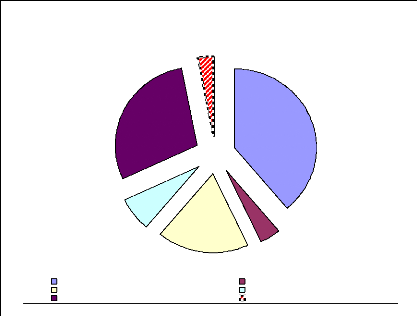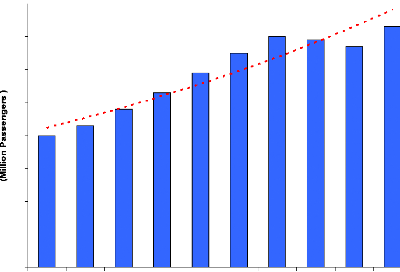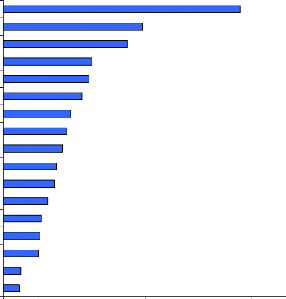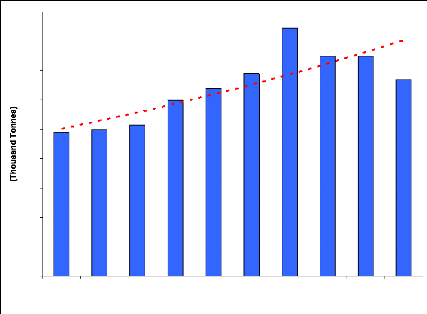2.4 Regulatory
In the absence of valid local carriers, ASECNA states have
liberalized their skies because bilateral agreements (Principle of reciprocity)
are no longer functioning. Although the deregulation process is on the way,
with the ongoing implementation of the Yamoussoukro8 liberalisation
decision, the open sky agreements, civil aviation codes are still obsolete and
not harmonised. Texts on competition are not fully applied:
Current regulations impose restrictions over the number of operating
airlines, and frequency and capacity.
Western carriers want more liberalization, and would like to see
the process speeded up, as they are in a position to dominate the market
further.
8 Ivory Coast, 1999
2.5 Air Travel demand
2.5.1 Traffic figures
Africa accounts for about 3% of global air traffic in term of
Passenger Kilometres performed (African Union, May 2005).
Figure 2.12: Regional share of global international
scheduled air passenger traffic

Europe Latin America and Caribbeans
North America Middle East
Asia Pacific Africa
587,998 (29%)
132,934 (7%)
Percentage share by region
( Passenger-kilometres
performed in millions, 2004)
354,353 (18%)
64,326 (3 %)
88,027 (4%)
785,828 (39%)
Source: UNESCAP, 20059
This situation reflects its low income, and the lack of air
transport infrastructure. This being said, the situation of air transport in
Africa is not uniform. It varies from one region to another. Northern, Southern
and Eastern Africa's air transport performance is good (Kenyan airways, South
African, Ethiopian and Royal Air Maroc). ASECNA area remains in a difficult
situation with less traffic and unreliable structures. ASECNA's figures show
that the region generates about 7 million passenger traffic per year (2003),
which is below what South Africa alone represents in term of annual air
passengers.
9 United Nation Economic and Social Commission for
Asia Pacific
Propensity to travel
Given the low level of incomes, and the widespread of poverty
across the region, the propensity to travel is very low. Moreover, the tariffs
are «very high», 20 to 30% higher than the rest of the world
according to the African Union. High air travel fares reflect the low level of
traffic, and limited load factors in most of the routes. Moreover, there are
little frequencies between city pairs. That increases aircraft operating
costs.
Passenger Traffic10
Figure 2.13: Evolution of passenger traffic
(1994-2003)

8,0
7,0
6,0
5,0
4,0
4,0
7,3
3,0
2,0
1,0
0,0
1994 1995 1996 1997 1998 1999 2000 2001 2002 2003
(Year)
Source: ASECNA, annual reports (1994-2003)
Passenger traffic has grown by about 75% from 1994 to 2003,
increasing from about 4 million to around 7 million in 2003.
This evolution is due to a sustained economic growth on the continent
and worldwide. Traffic recovery is particularly significant in some countries.
After recent political unrests in Madagascar and Congo, passenger traffic in
main airports grew respectively by 70 and 17 per cent between 2002 and 2003.
The increase of figures in the region is also driven by oil- related activities
in Chad and
10 Ässengers Traffic in ASECNA main Airports
Equatorial Guinea. The construction of the pipeline between that
country and the oceanic coast through Cameroon has stimulated traffic.
Passenger Traffic by Airport
Figure 2.14: Average Airport Passenger Traffic
(2000-2004)
Dakar (Senegal)
Abidjan (Ivory Coast)
Libreville (Gabon)
Douala (Cameroun)
Brazzaville (Rep Congo)
Antanarivo (Madagascar)
Pointe Noire (Rep Congo)
Bamako (Mali)
Malabo (Guinea)
Port Genrtil (Gabon)
Cotonou (Benin)
Yaounde (Cameroon)
Ouagadougou (Burkina)
LOME (Togo)
Nouakchott (Mauritania)
Ndjamena (Chad)
Niamey (Niger)

787
700
500
484
1336
0 200 400 600 800 1000 1200 1400 1600
(Thousand Passengers)
Source: ASECNA, annual reports (2000-2004)
Among the main airports, Dakar airport is the first in the
region with more than 1 million passengers per year. It's has been the fastest
growing airport in term of passenger volume. The important tourism activity in
Senegal is the major factor that explains this performance. The traffic is
globally increasing in other airports.
Secondary airports in ASECNA receive insignificant passenger
traffic and are often served by very small aircraft.
Domestic passenger traffic
Domestic markets are particularly poorly developed across the
region. People tend to travel by road or rail despite the poor state of the
network. Only the elite, and business men who can afford it, use air travel to
move within countries. Only Gabon has a relatively developed domestic market
with more than 340,000 passengers in 2003 (Bergonzi, 2006, P7).
Regional passenger traffic
While regional traffic has significantly increased within the
other African regions, it has stagnated in West and Central Africa from 1994 to
2001.
Political trips, seminars, regional emigration and business
travels are the main drivers of regional traffic. However, the mobility from
one country to another remains extremely difficult. It's sometimes easier to
reach another country within the region through Paris for instance. On the 276
regional city pairs, only 5 per cent of them have 150 passengers per day (table
below). The busiest city-pair is Abidjan - Dakar.
|
Daily passenger
|
Number of
city pairs
|
Percentage (%)
|
|
More than 150
|
14
|
5
|
|
70 - 150
|
28
|
10
|
|
30 - 70
|
69
|
25
|
|
10 - 30
|
69
|
25
|
|
Less than 10
|
96
|
35
|
Table 2.3: Daily passenger traffic between city
pairs.
Source: Délia Bergonzi, 2006
The most frequent connections in ASECNA are: Dakar-Bamako,
Dakar-Abidjan, Bamako-Abidjan, Douala-Libreville, and Cotonou - Pointe Noire.
They all have more then 100,000 passengers per year. Dakar and Abidjan are the
two destinations with the highest regional passenger traffic, performing
respectively 350000 and 200000 passengers per year (OEDC, 2005). Dakar has 15
direct links with others regional cities and Abidjan is directly linked to 12
others West African cities. The heaviest traffic flows are the Gulf of Guinea
(Abidjan-Accra-Lagos corridor), then the Dakar/Abidjan axis.
The lack of air links in the Central and
Western regions is at a damaging situation with the presence of a number of
landlocked states (e.g. Congo, Central African Republic, Chad, Mali, Niger),
where aviation is needed most.
International Passenger traffic
Almost 50% of passenger traffic (6 million out of 11 in 2003)
in western and central Africa is international. Traffic at major airports in
ASECNA is presented in table below.
|
2000
|
2001
|
2002
|
2003
|
|
Dakar
|
803.8
|
863.2
|
918.3
|
1005.6
|
|
Abidjan
|
744.6
|
6448
|
301.9
|
3127
|
|
Douala
|
198.8
|
252.9
|
246
|
283.5
|
|
Bamako
|
168.2
|
132.2
|
112.1
|
197.1
|
|
Antananarivo
|
198.2
|
209.9
|
98.5
|
176.1
|
|
Libreville
|
246.4
|
203.9
|
198.9
|
149.6
|
|
Malabo
|
42
|
64
|
73,9
|
100.2
|
Table 2.4: International traffic at major regional
airports (Thousand).
Source: ASECNA
In international traffic, for the West and Central Africa region,
and particularly in ASECNA, the dominant connection is towards Europe.
This traffic can be divided in 3 groups: The ethnic
Passenger Group, who has ties with the former European colonial powers,
France mainly, creates a natural emigration of workers in both directions
(South-North, North-South). The Leisure and Tourism group, concerns
high-income people who travel to Europe, America or Asia for reasons such as
shopping, Visits to family and friends. The Business travellers,
because of economic ties with Europe, and oil companies are also important
drivers for air traffic in the region. A large part of the traffic is also due
to governmental, non-governmental and international bodies' staff.
Traffic towards the Middle East is increasing, mostly due to
the attraction of Dubai and
pilgrimage to Mecca. North Africa / West and
Central Africa traffic is also increasing
due to the dynamism of Maghrebian airlines, which take a large
share of the 6th freedom11 traffic departing from Paris to
ASECNA.
There is also a significant traffic between African sub
regions and ASECNA, mainly towards South Africa. Traffic towards the United
States of America is carried out essentially via Europe.
Cargo Traffic
Figure 2.15: Evolution of Cargo traffic
(1994-2003)

1994 1995 1996 1997 1998 1999 2000 2001 2002 2003
(Year)
134
180
160
140
120
100
80
60
40
20
0
98
Source: ASECNA, annual reports (1994-2003)
Freight traffic has regularly increased from 1994 to 2000 due
to economic upturn. The
decrease observed since 2001 is
explained by a dramatic reduction of cargo traffic at
11 The right to carry passengers or cargo from a second country
to a third country by stopping in one's own country.
main cargo airports (Pointe Noire and Brazzaville in the republic
of Congo). But overall cargo traffic has increased by nearly 37 per cent since
1994.
| 


